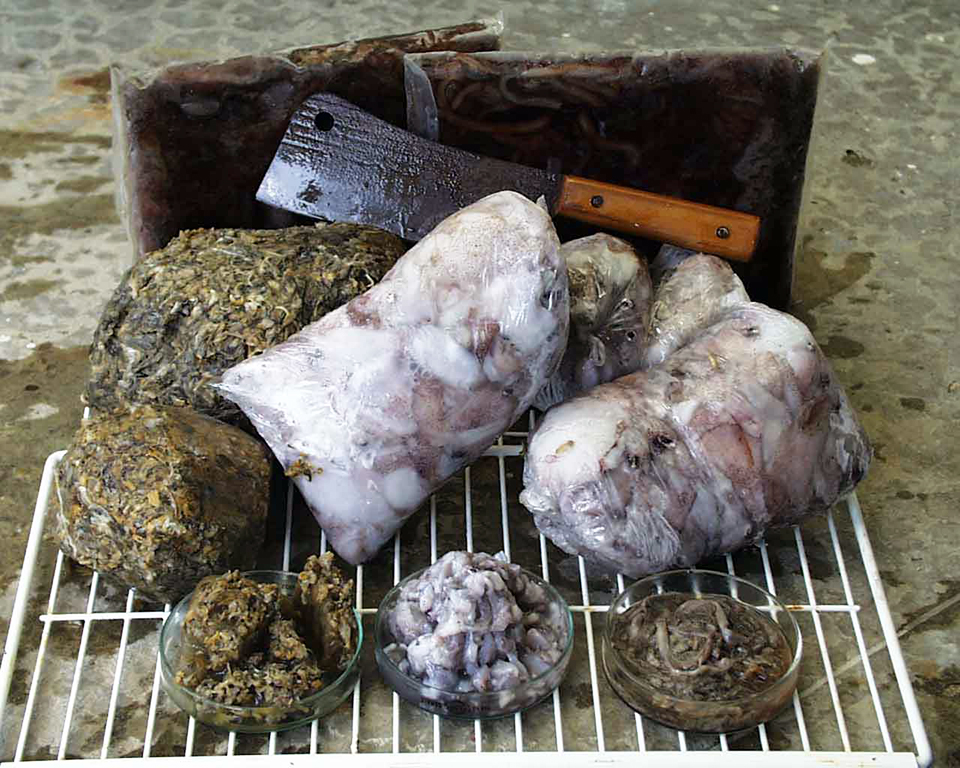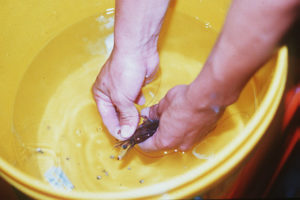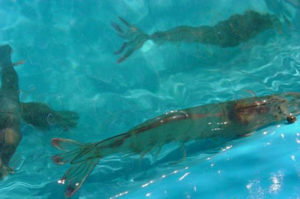Current state of knowledge contains many gaps

Research into shrimp broodstock nutrition will be a key element in the further use of domesticated and genetically selected stocks for aquaculture. The development of genetically improved lines of shrimp may benefit from a simultaneous development of feeds specifically tailored to individual strain requirements.
Also, the high cost of feed in captive broodstock maturation facilities – estimated at around 30 percent of total cost, as well as a heavy reliance on fresh feed items such as squid, mollusk meals, and polychaete worms that can vary in quality and availability, suggests a need for specifically formulated maturation diets.
In 2001, the main author reviewed the available literature on shrimp broodstock diets and commented on the lack of scientific publications on the subject, possibly due to the expense and complexity of conducting experiments in this field.
Very little research has been conducted on formulated diets as a sole nutrition source. Most studies report on fresh feeds, used either alone or in combination with formulated diets or dietary supplements.
Maturation and nutrition
During shrimp maturation, nutrient reserves, mainly from the hepatopancreas, are mobilized to support ovarian and testicular maturation. Tissue reserves can be depleted rapidly, so the diet becomes the most important contributor of nutrients to the developing eggs. This is particularly true when eyestalk ablation is used to accelerate maturation.
The hormonal and metabolic changes that come during such forced maturation can take place when nutrient reserves are insufficient to support rapid ovarian development. This places an even larger burden on the diet as a source of essential nutrients.
Lipids
During maturation, stored lipids are mobilized from the hepatopancreas and dietary lipids are rapidly processed for transport to the developing ovaries. The importance of lipids in maturation has long been recognized, and much of the reported work has focused on lipid nutrition, especially the importance of highly unsaturated fatty acids (HUFAs) and phospholipids.
The 10 percent average lipid levels in commercial broodstock diets are around 3 percent higher than those in standard grower feeds. The total lipid level in the diet does not appear to be important, although one study reported that total lipid levels above 9 percent had an adverse effect on the onset of ovarian maturation and feed consumption of Pacific white shrimp (Litopenaeus vannamei), possibly due to satiation effects.
HUFAs, especially eicosapentaenoic acid and docosahexaenoic acid, are abundant in ovarian tissues. They are believed to be important components of maturation diets, since diets deficient in these omega-3 HUFAs have been found to have negative effects on ovarian development, fecundity, and egg quality.
Arachidonic acid (20:4 omega-6) has been detected at high levels in the ovaries of wild shrimp and is also abundant in some of the best fresh feed items, such as polychaetes (bloodworms), clams, and mussels. The omega-6 HUFAs are precursors of the prostaglandin hormones that may play a role in reproduction and vitellogenesis.
Many formulated maturation diets appear deficient in arachidonic acid and have relatively low levels of eicosapentaenoic acid. An omega-3:omega-6 ratio of dietary HUFAs around 3:1 has been proposed for optimum reproductive performance.
Phospholipids, mainly phosphatidylcholine and phosphatidyletanolamine, are predominant in shrimp ovaries. Several studies have demonstrated a requirement for phospholipids in the diet, with a 2 percent level suggested for broodstock diets to ensure that 50 percent of total egg lipid is in this form.
During maturation, the level of triacylglycerides in the ovaries increases as they are incorporated into the eggs. Triacylglycerides appear to be the principal energy source in eggs and nauplii, and their importance in reproduction, and egg and postlarval quality has been demonstrated.
Protein and amino acids
Maturation involves intense protein synthesis, and it is likely that requirements for protein are higher at this time. Detailed studies of the protein requirements for shrimp broodstock are still lacking, although it has been suggested that the amino acid profiles of live feeds could provide a target amino acid profile.
Some studies have shown an increase in protein content of the ovaries associated with egg development and spawning, and spawning success. Markedly higher protein content has been noted in the hepatopancreases and ovaries of L. vannamei females with good repeat spawning performance compared to females with poor spawning performance. The protein content of formulated diets is typically around 50 percent – low compared to the levels in fresh feeds (Table 1).
Wouters, Proximate analysis of fresh food dietary treatments, Table 1
| Proximate Analysis | Fresh Food (%) A | Fresh Food (%) B | Commercial Diet (%) Range | Commercial Diet (%) N |
|---|
Proximate Analysis | Fresh Food (%) A | Fresh Food (%) B | Commercial Diet (%) Range | Commercial Diet (%) N |
|---|---|---|---|---|
| Protein | 58 | 73 | 40-54 | 7 |
| Lipid | 11 | 8 | 8-14 | 7 |
| Fiber/Starch | ns | ns | 2-16 | 7 |
| Ash | ns | 8 | 9-20 | 7 |
| Moist | ns | 80 | 7-20 | 7 |
ns = not specified
A = squid, bloodworm, shrimp, and Artemia – 4:2:2:1 ratio
B = squid and mussel – 1.3:1 ratio
Carbohydrates
Carbohydrates do not appear essential for shrimp broodstock diets, although egg glucose levels have been equated with larval quality and broodstock condition. Carbohydrates can be used as cost-effective ingredients and binders, and possibly can play a role in the transport of nutrients in the haemolymph.
Vitamins and minerals

Detailed vitamin and mineral requirements for shrimp broodstock diets are relatively unknown, with only a few studies completed on vitamins A, C and E. Vitamin E deficiency has been correlated with abnormal sperm in Atlantic white shrimp (Litopenaeus setiferus) and improvement in egg-hatching rates has been observed with increasing dietary vitamin E correlated to higher levels in the eggs.
A correlation has also been observed between levels of alpha tocopherol in the diet, and spawn and hatch quality in wild spawners and the nauplii of L. vannamei. Vitamin E in the egg yolk may also act as a natural antioxidant.
Vitamin A accumulates in the ovaries of crustaceans during maturation, suggesting a role for dietary sources of the vitamin. The vitamin C content of Indian white shrimp, Fenneropenaeus indicus, eggs is influenced by the levels in the diet. High hatching rates have been related to high ascorbic acid levels in the eggs. Vitamin D is also thought to be important in broodstock diets due to its probable role in calcium and phosphorus metabolism in crustaceans.
Mineral deficiencies or imbalances can have negative impacts on crustacean reproduction and may play a role in oocyte resorption, reduction in reproductive performance, and egg quality. Studies of mineral requirements are rare, but where conducted, their diets were formulated with mineral mixes with added calcium, phosphorus, magnesium, sodium, iron, manganese, and selenium.
Spent broodstock of L. vannamei have lower levels of calcium and magnesium in muscles and lower magnesium levels in their hepatopancreases, possibly due to a combination of dietary deficiencies and losses through molting and transfer to the eggs. Copper decreases in the hepatopancreas, possibly through transfer to the ovaries, although it increases in muscle tissue. It is clear that more studies need to be undertaken on mineral nutrition in broodstock diets for penaeid shrimp.
Carotenoids

Carotenoids, especially astaxanthin, are strong antioxidants that probably play roles in protecting broodstock nutrient reserves and developing embryos from oxidation. They also reportedly act as pigment reserves in embryos and larvae for the development of chromatophores and eyespots, and as a vitamin A precursor.
Since crustaceans cannot synthesize carotenoids, dietary sources of these pigments are required. During sexual maturation, carotenoids accumulate in the hepatopancreas. During vitellogenesis, they are transported in the hemolymph as carotenoglycolipoproteins to accumulate in the eggs as part of the lipovitellin protein.
The level of pigments required for a given dietary concentration may be directly related to the similarity of the carotenoid to astaxanthin and beta-carotene. Astaxanthin is more abundant than beta-carotene and has stronger pigmentating and antioxidant properties, but is poorly converted to retinoids compared with beta-carotene.
Retinoids, in turn, are believed to activate endocrine mechanisms essential for maturation and embryonic development. Eyestalk ablation, however, affects most of the biochemical reactions involved in the metabolism of carotenoids and could prevent the action of bioactive retinoids. Both astaxanthin and beta-carotene are therefore recommended in the diets of ablated spawners.
Decreases in nauplii quality with successive spawns have been associated with a loss of pigmentation in the ovaries of L. vannamei. The addition of paprika, an inexpensive source of carotenoids, to the fresh diet at a rate of 2 percent has resulted in significant improvements in nauplii survival to zoea 2 stage. Astaxanthin supplementation at 50 milligrams per kilogram of the diet has resulted in increased egg production in black tiger shrimp (Penaeus monodon), but no benefits have been shown for either hatching rate or metamorphasis to zoea 1 stage.
Hormones
Studies suggest that live feed organisms provide benefits through the provision of hormones or their precursors. Part of the success of artemia biomass supplementation of broodstock diets could be due to the presence of specific hormones or analogous peptides in the artemia. Polychaetes used in maturation contain methyl farnesoate, a hormone shown to increase reproductive performance.
Nucleotides
Traditionally, nucleotides are not considered essential nutrients, although several studies have demonstrated that dietary sources of nucleotides can have beneficial effects. Exogenous sources of nucleotides are thought to optimize the functions of rapidly dividing tissues, such as those of the developing embryo and young, and the reproductive and immune systems.
Reproduction and egg development have a high requirement for RNA and DNA, and increasing the availability of nucleotides in broodstock diets may have a beneficial effect on egg development. Recently, research has shown that nucleotide enrichment of broodstock diets for Atlantic halibut (Hippoglossus hippoglossus) and haddock (Melanogrammus aeglefinus) resulted in a general trend toward better spawning performance and egg quality. To date, no work has been published on the nucleotide supplementation of broodstock diets for shrimp.
Conclusion
The current state of knowledge of broodstock nutrition for crustaceans contains many gaps. This is partly the result of the complexity and expense of conducting research in this area.
The role of nutrition in broodstock and maturation performance will be fundamental in obtaining optimal performance from domesticated stocks. Even in species where domestication is not an issue, the improvement of maturation performance and larval production remains a key goal in improving the efficiency of production systems.
(Editor’s Note: This article was originally published in the June 2004 print edition of the Global Aquaculture Advocate.)
Now that you've finished reading the article ...
… we hope you’ll consider supporting our mission to document the evolution of the global aquaculture industry and share our vast network of contributors’ expansive knowledge every week.
By becoming a Global Seafood Alliance member, you’re ensuring that all of the pre-competitive work we do through member benefits, resources and events can continue. Individual membership costs just $50 a year. GSA individual and corporate members receive complimentary access to a series of GOAL virtual events beginning in April. Join now.
Not a GSA member? Join us.
Authors
-
Roeland Wouters, Ph.D.
INVE Technologies N.V.
Hoogveld 93, B-9200 Dendermonde
Belgium -

Daniel F. Fegan
Alltech Inc.
Bangkok, Thailand
Tagged With
Related Posts

Health & Welfare
A comprehensive look at the Proficiency Test for farmed shrimp
The University of Arizona Aquaculture Pathology Laboratory has carried out the Proficiency Test (PT) since 2005, with 300-plus diagnostic laboratories participating while improving their capabilities in the diagnosis of several shrimp pathogens.

Responsibility
A helping hand to lend: UK aquaculture seeks to broaden its horizons
Aquaculture is an essential contributor to the world food security challenge, and every stakeholder has a role to play in the sector’s evolution, delegates were told at the recent Aquaculture’s Global Outlook: Embracing Internationality seminar in Edinburgh, Scotland.

Health & Welfare
A holistic management approach to EMS
Early Mortality Syndrome has devastated farmed shrimp in Asia and Latin America. With better understanding of the pathogen and the development and improvement of novel strategies, shrimp farmers are now able to better manage the disease.

Health & Welfare
A look at aquaculture in Guyana
With its large quantities of water and little industry to pollute it, Guyana has the potential to become a greater player in global aquaculture.


